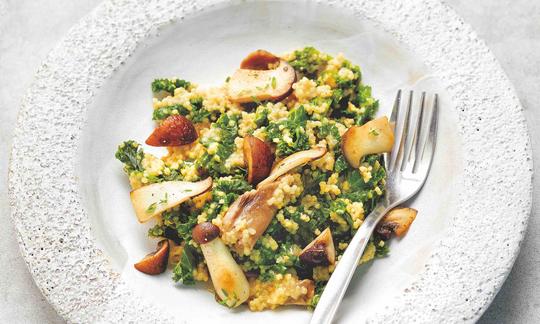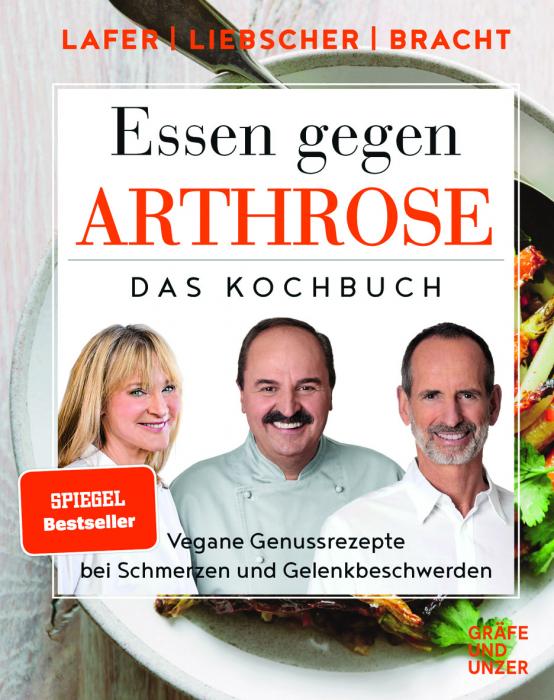Kale-Herbsotto with Mushrooms and Thyme
vegan
Ingredients (for servings, )
| ½ oz | Porcini mushrooms, dried (raw?, organic?) |
| 150 ml | Drinking water, raw (organic?) (5.3 oz) |
| 1 | Onions, raw (organic?) (3.9 oz) |
| 2 cloves | Garlic (organic?) (0.21 oz) |
| 8 ½ oz | Kale, raw (spring cabbage, organic?) |
| 5 tbsp | Rapeseed oil, refined (organic?) (2.5 oz) |
| 7 ⅔ oz | Millet, raw (golden millet, panicle millet, millet, organic?) |
| 750 ml | Vegetable broth without added salt (organic?) (26 oz) |
| 8 ½ oz | Cultivated mushrooms, raw (organic?) |
| 8 ½ oz | Raw king oyster mushrooms (organic?) |
| 5 sprigs | Thyme, raw (organic?) (0.33 oz) |
| 1 dash | Table salt (table salt, raw?, organic?) (0.01 oz) |
| 1 dash | Black pepper (organic?, raw?) (0.00 oz) |
Equipment
- skillet (frying pan)
- stove
- saucepan
- salad spinner
Type of preparation
- cook
- fry
- chop or grind
- soak
- sweat
- season to taste
- remove the skin
- drain
Preparation
Preparing the vegetables
Soak the dried porcini mushrooms in 150 ml of hot water for about 10 minutes. In the meantime, peel the onion and garlic and dice finely. Wash the kale thoroughly, spin dry and tear into bite-sized pieces.Preparation of the millet risotto
Heat about ¼ of the oil in a large pot and briefly sauté the onion, garlic and kale. Add the millet and fry briefly while stirring. Add the porcini mushrooms and their soaking liquid. Pour in a little hot stock so that everything is just covered. Then cook the millet uncovered for about 20 minutes while stirring. Keep adding a little hot stock as soon as it is almost completely absorbed.In the meantime, clean the mushrooms, wipe them dry if necessary, and cut into slices. Pick off the thyme leaves and chop them. Just before the millet is cooked, heat the remaining oil in a pan and fry the mushrooms with the thyme over a medium to high heat for 5 minutes. Season generously with salt and pepper.
We used button mushrooms and oyster mushrooms. However, you can also use chanterelles or other mushrooms instead or in addition.
Finishing and Serving
Season the millet risotto with salt and pepper and divide between plates. Arrange the fried mushrooms on top. Serve immediately.
|
Nutritional Information per person
Convert per 100g
|
2000 kcal | |
|---|---|---|
| Energy | 505 kcal | 25.3% |
| Fat/Lipids | 24 g | 34.7% |
| Saturated Fats | 3.9 g | 19.5% |
| Carbohydrates (inc.dietary fiber) | 62 g | 22.9% |
| Sugars | 6.1 g | 6.8% |
| Fiber | 13 g | 53.9% |
| Protein/Albumin | 16 g | 31.2% |
| Cooking Salt (Na:113.8 mg) | 289 mg | 12.0% |
| Essential micronutrients with the highest proportions | per person | 2000 kcal | |
|---|---|---|---|
| Vit | Vitamin K | 478 µg | 638.0% |
| Min | Copper, Cu | 1.9 mg | 186.0% |
| Vit | Vitamin C (ascorbic acid) | 90 mg | 113.0% |
| Vit | Vitamin B9, B11 (Folate, as the active form of folic acid) | 193 µg | 97.0% |
| Fat | Alpha-Linolenic acid; ALA; 18:3 omega-3 | 1.9 g | 95.0% |
| Min | Manganese, Mn | 1.6 mg | 82.0% |
| Prot | Tryptophan (Trp, W) | 0.19 g | 76.0% |
| Vit | Vitamin B3 (Niacin) | 11 mg | 71.0% |
| Vit | Vitamin A, as RAE | 553 µg | 69.0% |
| Vit | Vitamin B7 (Biotin, ex vitamin H) | 30 µg | 61.0% |
Detailed Nutritional Information per Person for this Recipe
The majority of the nutritional information comes from the USDA (US Department of Agriculture). This means that the information for natural products is often incomplete or only given within broader categories, whereas in most cases products made from these have more complete information displayed.
If we take flaxseed, for example, the important essential amino acid ALA (omega-3) is only included in an overarching category whereas for flaxseed oil ALA is listed specifically. In time, we will be able to change this, but it will require a lot of work. An “i” appears behind ingredients that have been adjusted and an explanation appears when you hover over this symbol.
For Erb Muesli, the original calculations resulted in 48 % of the daily requirement of ALA — but with the correction, we see that the muesli actually covers >100 % of the necessary recommendation for the omega-3 fatty acid ALA. Our goal is to eventually be able to compare the nutritional value of our recipes with those that are used in conventional western lifestyles.
| Essential fatty acids | per person | 2000 kcal |
|---|---|---|
| Alpha-Linolenic acid; ALA; 18:3 omega-3 | 1.9 g | 95.0% |
| Linoleic acid; LA; 18:2 omega-6 | 4.8 g | 48.0% |
| Essential amino acids | per person | 2000 kcal |
|---|---|---|
| Tryptophan (Trp, W) | 0.19 g | 76.0% |
| Threonine (Thr, T, irreversibly transaminated) | 0.44 g | 47.0% |
| Leucine (Leu, L) | 1.1 g | 46.0% |
| Valin (Val, V) | 0.67 g | 42.0% |
| Isoleucine (Ile, I) | 0.47 g | 38.0% |
| Phenylalanine (Phe, F) | 0.53 g | 34.0% |
| Lysine (Lys, K, irreversibly transaminated) | 0.44 g | 24.0% |
| Methionine (Met, M) | 0.21 g | 23.0% |
| Vitamins | per person | 2000 kcal |
|---|---|---|
| Vitamin K | 478 µg | 638.0% |
| Vitamin C (ascorbic acid) | 90 mg | 113.0% |
| Vitamin B9, B11 (Folate, as the active form of folic acid) | 193 µg | 97.0% |
| Vitamin B3 (Niacin) | 11 mg | 71.0% |
| Vitamin A, as RAE | 553 µg | 69.0% |
| Vitamin B7 (Biotin, ex vitamin H) | 30 µg | 61.0% |
| Vitamin E, as a-TEs | 7.2 mg | 60.0% |
| Vitamin B2 (Riboflavin) | 0.83 mg | 59.0% |
| Vitamin B6 (pyridoxine) | 0.65 mg | 47.0% |
| Vitamin B5 (Pantothenic acid) | 2.3 mg | 39.0% |
| Vitamin B1 (Thiamine) | 0.42 mg | 38.0% |
| Vitamin D | 0.12 µg | 3.0% |
| Vitamin B12 (Cobalamin) | 0.02 µg | 1.0% |
| Essential macroelements (macronutrients) | per person | 2000 kcal |
|---|---|---|
| Potassium, K | 1'105 mg | 55.0% |
| Phosphorus, P | 342 mg | 49.0% |
| Magnesium, Mg | 128 mg | 34.0% |
| Calcium, Ca | 145 mg | 18.0% |
| Sodium, Na | 114 mg | 14.0% |
| Essential trace elements (micronutrients) | per person | 2000 kcal |
|---|---|---|
| Copper, Cu | 1.9 mg | 186.0% |
| Manganese, Mn | 1.6 mg | 82.0% |
| Iron, Fe | 4.9 mg | 35.0% |
| Zinc, Zn | 2.8 mg | 28.0% |
| Selenium, Se | 8.2 µg | 15.0% |
| Iod, I (Jod, J) | 20 µg | 13.0% |
| Fluorine, F | 46 µg | 1.0% |
GRÄFE UND UNZER Verlag GmbH / Ganzke Verlagsgruppe, Johann Lafer
Raw recipes 6, Cooked recipes 78 (3)
Additional photos (3)
Food for arthritis - The cookbook contains delicious vegan recipes for a diet for arthritis as well as information on pain and joint problems.
Since this book is written in German, a description is omitted here. If you are interested, please switch to German in the menu.
The kale millet risotto with mushrooms and thyme is a successful, healthy variation of a traditional risotto that is very easy to prepare.
Nutrient profile: According to GDA guidelines, one portion of this recipe covers several times the average daily requirement of vitamin K. Vitamin K plays an important role in blood clotting and bone metabolism. It also covers the average daily requirement of copper and vitamin C. The ratio of omega-6 to omega-3 fatty acids is 3:1, which is below the maximum recommended ratio of 5:1. More on this under: Vegans often eat unhealthily. Avoidable nutritional errors.
However, the vegetables lose some of their nutrients when heated during cooking. Since the nutrient profile primarily refers to the uncooked ingredients, the values are actually somewhat lower.
Millet: Millet or panicle millet (real millet) is a grain that is very rich in minerals. Compared to other grains, it contains a particularly high amount of silicon (silica), iron and vitamin B6. It comes from the grass family and has been used in Central Asia for 8,000 years to make unleavened flatbread. In the trade, golden millet means millet that has been freed from the husk. However, since most of the minerals adhere to the husk, the mineral content of golden millet is lower than that of unhulled millet!
Kale: Kale is a fast-growing and globally widespread type of cabbage that is descended from wild cabbage ( Brassica oleracea L.). This robust winter vegetable is also known in Switzerland as kale and is one of the foods richest in vitamin C.
Mushrooms: The button mushroom is the most common cultivated mushroom. The flesh of the round mushroom is white and firm, the taste mild. The brown button mushroom is a special variety that is less sensitive to pressure and has a more intense flavor than the white variety. Unlike wild mushrooms, you can buy cultivated mushrooms in stores all year round.
Oyster mushrooms: Oyster mushrooms (Pleurotus), also known as king oyster mushrooms or king oyster mushrooms, are a genus of mushrooms from the family of oyster mushrooms. Oyster mushrooms have a delicate aroma. Like porcini mushrooms, oyster mushrooms are available in brown or pale colors, although the flesh of the brown oyster mushroom has a porcini-like consistency. The aroma of the oyster mushroom is also similar to that of the porcini mushroom. It is also cultivated. Like the button or porcini mushroom, it can also be eaten raw.
Low-salt vegetable stock: We deliberately use low-salt vegetable stock to reduce the overall amount of salt without sacrificing flavor. Use your own preference as a guide when adding salt to this dish.
Homemade vegetable stock: By making salt-free vegetable stock, the salt content can be reduced significantly. Access our recipe via this link: Vegan vegetable stock. Adjust the amount of stock depending on how concentrated it is. Add salt as needed before serving.
We replaced the olive oil with refined rapeseed oil. Compared to olive oil, rapeseed oil has a much better ratio of omega-6 to omega-3 fatty acids. Cold-pressed rapeseed oil is not suitable in this case, as cold-pressed oils can only be heated slightly, in the case of cold-pressed rapeseed oil up to a maximum of 120 °C, otherwise harmful substances are created. See the following link ( cold-pressed rapeseed oil). But even refined rapeseed oil should only be heated to a maximum of 180 °C. Under no circumstances should it start to smoke, although decomposition begins before that.
Simplification: You can also simplify the dish by using only button mushrooms as the fresh mushrooms and leaving out the dried porcini mushrooms. The dish will then taste different from the original recipe, but it will still be very tasty.




